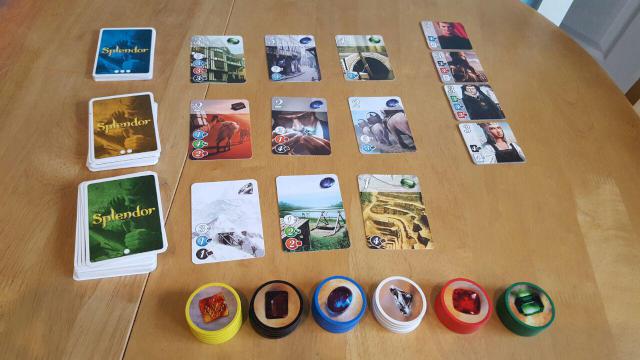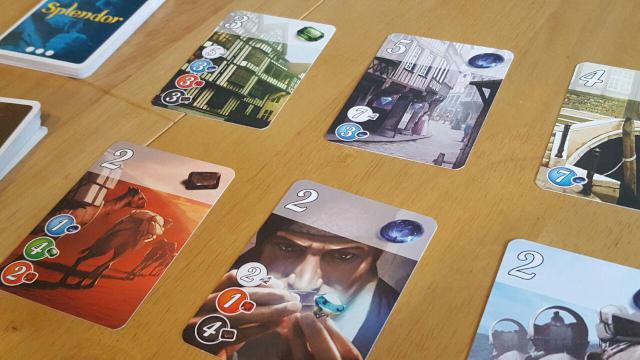
Splendor is, at its most basic, a game about buying cards with gems. The more gems you’ve got at your disposal the better the cards you can buy; the better the cards are the more points they’re worth throughout the game. Simple.
Sorry, did I say simple? Sure, the rules are simple. But winning? No. Not simple at all.
The general theme of the game is that you’re a Renaissance merchant, and it’s your job to try and collect as many locations as possible while keeping yourself well stocked with gems. In reality that’ll probably get lost within minutes of explaining that to anyone, but that’s ok – it makes no difference to the game in any way, shape or form whether or not you understand the theme. The key thing is that you work out just how you’re going to buy the cards worth more points when you can’t have enough gems in your pocket…

See, there’s a limit to how many gems you can have at any one time, and the better cards available tend to cost more than your maximum allowance. To get round this problem every card you buy has another gem in the top corner, and every one of these card based gems you have can be counted towards your available currency. So if, for example, you need 6 diamonds to buy a card but only have 3 diamond gems in your pile you can check the cheaper cards you’ve already bought; if there are 3 diamonds among them you’re in luck. But this leads to another strategic call – do you try to max out on one or two types of gem, or go for a more balanced savings plan? After all, on each turn you can either buy a card or take 3 gems from the remaining pile, so you’ve got a decision to make each time it’s your go. And what about point scoring? The more pricey cards have bigger scores attached but take longer to save for, do you try and gather enough currency to go for the big points, or stock up on the cheaper cards which cost less to buy but provide less reward as a result?
The truth is there’s no right or wrong way to play, you need to adapt to how the game is panning out. There are also noble cards, which can be won by having cards in your purchased pile whose gems match the noble requirements, and these give pretty hefty point rewards by themselves. But without remembering what every other player has bought you might end up ruining your plan by aiming for a noble card, only for another player to swipe it just before you had the final card you needed. When that happens you might be stuck with a combination of gems that you didn’t want for the longer game; on the other hand you might get lucky and be able to buy some decent cards instead. You won’t know until it happens.
Eventually someone will have enough points to win. There’s no round limit, no time limit, you just keep on going until someone has enough points. Initially that’ll feel like it’s going to take an eternity, but as everyone starts building a deck of purchased cards and therefore upping the gems they can quickly and easily spend, the scores start to shoot up pretty quickly. A game which one minute felt like it was going nowhere can be over 10 minutes later – you certainly can’t afford to snooze on the job.

Something else worth noting is the components you’ll find in the box. We’re getting used to Space Cowboys making some great looking games, and in this case the gems (which could easily have been pop-out cardboard tokens) are actually very similar to plastic poker chips in terms of size and weight, and feel great to handle when you’re picking them up or spending them. The cards are pretty standard fare, but the artwork is quite nice and the important information on them is crystal clear, which is handy when playing with people new to board games.
And finally there’s the obligatory “TGR 3 Year Old Test” (T3YOT for short), which admittedly now needs renaming since my son turned 4, but never mind. The name wasn’t going to catch on anyway. Still, this is definitely a game a younger kid can get involved in. The full rules, as is often the case, are a little too much but the idea of being a “cashier” for the gems and cards was something he loved. You might want to leave Dead of Winter until your little ones are in bed, but Splendor is something they can get actively involved in. Some of you might not care about that, but for us it’s a huge deal and makes organising a games session with friends far more straightforward.
Splendor, then, is another of those games which anyone can play. Not only that, it’s a game that most people will want to play. There’s no half-hour rule explanations, no digging through huge manuals to clarify rules, just an easy to learn game which (probably as a result of being so easy to learn) is a royal pain in the backside to try and win. It’s a shame the theme doesn’t carry through better, but that’s no biggie, you should still pick this up for your family games nights.
Splendor
Available Now, RRP £24.99
Find your local stockist here

Leave a Reply